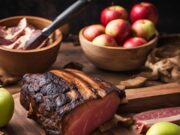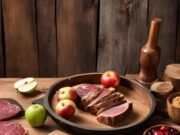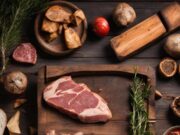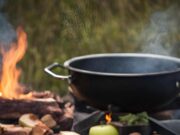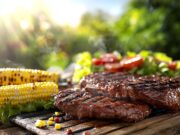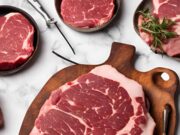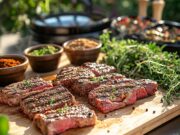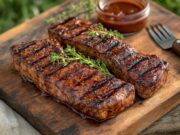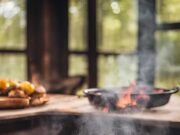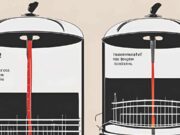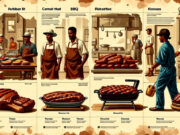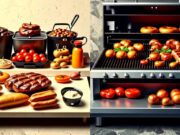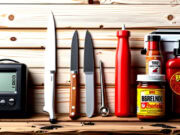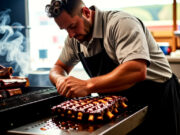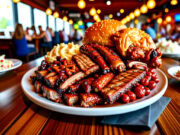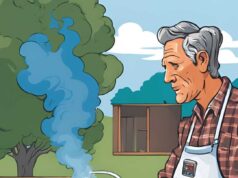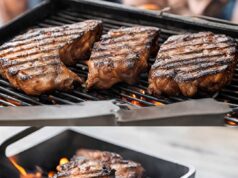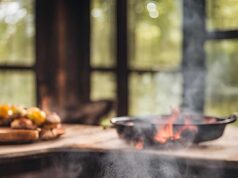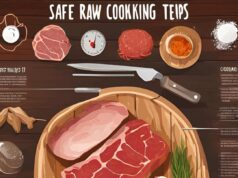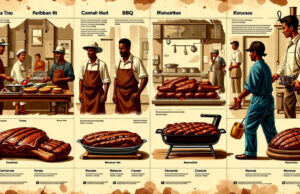- Key Takeaways:
- Understanding Charcoal Grill Basics
- Essential Tools for Temperature Control
- Preparing and Lighting Your Charcoal
- Managing Airflow for Temperature Control
- Setting Up Cooking Zones
- Monitoring and Adjusting Temperature During Cooking
- Troubleshooting Common Temperature Issues
- Frequently Asked Questions
Grilling with charcoal can significantly enhance your outdoor cooking experience; however, maintaining a consistent temperature is crucial for achieving the perfect barbecue.
This guide will help you understand the fundamentals of charcoal grilling, including how your grill operates and the essential tools required for effective temperature control.
You will learn about lighting your charcoal, managing airflow, setting up cooking zones, and troubleshooting common temperature issues.
Prepare to master your grill and impress your guests with perfectly cooked meals on every occasion.
Key Takeaways:
- Understand the basics of how a charcoal grill works to better control temperature.
- Use essential tools like a thermometer and vents to regulate airflow and maintain consistent temperature.
- Prepare and light charcoal properly, and set up cooking zones for even heat distribution.
Understanding Charcoal Grill Basics
Understanding the basics of a charcoal grill is essential for any BBQ enthusiast. It requires familiarizing yourself with the different types of charcoal available, the significance of cooking methods like indirect heat, and how these elements contribute to achieving the desired cooking temperature for perfectly smoked meat.
Among the most common types of charcoal, briquettes and lump charcoal each offer distinct advantages and considerations. Briquettes typically burn more steadily and are easier to ignite, making them a preferred choice for beginners. On the other hand, lump charcoal is favored for its natural composition and high heat output, which is ideal for achieving those coveted sear marks.
When determining your grill setup, it’s crucial to consider not only the burn rates and heat production of your selected charcoal but also how to effectively manage airflow and placement. This will enhance flavor infusion and moisture retention in your grilled dishes.

Essential Tools for Temperature Control
To maintain optimal temperature control while grilling, several essential tools can significantly enhance your BBQ experience. Utilizing a temperature probe for accurate readings, a chimney starter for efficient charcoal lighting, and a water pan to help regulate moisture levels are just a few examples of how these tools can improve your cooking process.
The temperature probe, for instance, ensures that meats are cooked precisely to the desired doneness, eliminating guesswork and preventing the overcooking or undercooking that can undermine a meal. A chimney starter is invaluable for those who prefer a quick and hassle-free method for igniting charcoal, allowing for even heating without the need for lighter fluid. Meanwhile, the water pan not only helps maintain humidity in the cooking environment but also acts as a heat sink, ensuring stable temperatures even during longer cooking sessions.
Together, these tools contribute to a more enjoyable and efficient grilling experience, enableing you to achieve BBQ perfection.
Preparing and Lighting Your Charcoal
The preparation and lighting of charcoal are crucial steps in the grilling process. Utilizing a chimney starter can greatly simplify this task, providing a reliable heat source while ensuring that your briquettes catch fire evenly and safely for a consistent cooking temperature.
To begin, selecting the appropriate type of charcoal is essential. Lump charcoal burns hotter and faster, making it ideal for high-heat grilling, while briquettes offer a longer and more consistent burn for slower cooking.
Once you have made your selection, fill the chimney starter to about two-thirds capacity and place a few sheets of crumpled newspaper in the bottom. Light the newspaper and allow the flames to rise, which will ignite the charcoal above.
Typically, it takes about 15 to 20 minutes for the coals to turn gray and ashy, indicating that they are ready for grilling. For optimal heat control, you can spread the hot charcoal evenly for direct heat or pile them to one side for indirect cooking methods, providing versatility in your grilling endeavors.
Managing Airflow for Temperature Control
Effective airflow management is essential for controlling the temperature of your charcoal grill. By adjusting the air vents, you can regulate the intensity of the fire, which is crucial for achieving your desired cooking zones and enhancing the smoke flavor of the meat.
When grilling meats at high temperatures, such as searing steaks, it is important to open the vents fully. This promotes maximum airflow, ensuring a hotter and more aggressive fire. In contrast, when slow-cooking or smoking, partially closing the vents can help maintain a lower temperature, allowing the meat to cook evenly while absorbing that rich, smoky essence.
Utilizing techniques such as a digital thermometer to monitor internal grill temperatures can provide valuable insights into airflow effectiveness and heat distribution. Additionally, observing the burn pattern of the charcoal can guide necessary adjustments, ensuring consistently delicious results.
Setting Up Cooking Zones
Setting up cooking zones within your charcoal grill is essential for effective heat control. By utilizing a two-zone grill setup, you can create areas for both direct and indirect heat, providing versatile cooking methods for different types of food and allowing you to perfect your smoker setup.
This method not only maximizes flavor but also enhances your overall grilling experience. Direct heat is ideal for searing steaks, giving you those coveted grill marks, while indirect heat works best for larger cuts of meat or more delicate items like fish, allowing for slower cooking without the risk of burning.
By incorporating these distinct zones, you can achieve mouthwatering results, ensuring that your foods are cooked evenly and retain their natural juices. Indirect heat cooking also offers the added benefit of breaking down tougher meats over longer periods, resulting in tender dishes that make every meal unforgettable.
Understanding these techniques can transform any grilling session into a culinary delight.
Monitoring and Adjusting Temperature During Cooking
Monitoring and adjusting the temperature during cooking is crucial to ensure that your BBQ meats are cooked evenly and thoroughly. Utilizing a lid thermometer and regularly checking the coals allows you to make necessary temperature adjustments throughout the cooking process.
Temperature control goes beyond simply achieving an ideal cooking environment; it is essential for both food safety and flavor development. To effectively interpret readings from a lid thermometer, you should aim for specific temperature ranges that correspond to different types of meat.
For instance, chicken should reach an internal temperature of 165°F, while pork is best enjoyed at about 145°F. If the readings indicate that the temperatures are fluctuating, consider adjusting the airflow by opening or closing the dampers or adding more coals as needed. For more tips on maintaining consistent temperature in your charcoal grill, check out this helpful resource.
This attention to detail not only enhances the overall dining experience but also minimizes the risk of undercooking or overcooking your favorite meats.
Troubleshooting Common Temperature Issues
Troubleshooting common temperature issues in your charcoal grill can greatly enhance your cooking experience. By understanding the causes of temperature spikes, managing the burn rate of your coals, and ensuring adequate moisture with a water pan, you can effectively maintain a stable cooking environment.
This process involves recognizing how different techniques contribute to your overall grilling success. For instance, a high burn rate can lead to rapid temperature increases, which may overcook your food and create an undesirable texture. To counteract this, adjusting the air vents properly allows you to control the oxygen flow, thereby influencing the burn rate of the charcoal.
Incorporating moisture into the cooking environment with a water pan not only helps regulate temperature but also prevents your meats from drying out. By carefully balancing these factors, you can achieve perfectly cooked dishes while fully enjoying the benefits of grilling.
Frequently Asked Questions
What is the importance of maintaining a consistent temperature in your charcoal grill?
Maintaining a consistent temperature is crucial for achieving perfectly cooked food. Fluctuations in temperature can result in over or undercooked food, leading to a disappointing grilling experience.
How can I control the temperature in my charcoal grill?
To maintain consistent temperature, you can control the airflow by adjusting the vents on your grill. Open vents allow more oxygen to enter, increasing the temperature, while closed vents limit the oxygen, decreasing the temperature.
What is the ideal temperature for grilling on a charcoal grill?
The ideal temperature for grilling on a charcoal grill is between 225-250 degrees Fahrenheit. This low and slow method is perfect for cooking meats to juicy and tender perfection.
How can I prevent temperature fluctuations in my charcoal grill?
One way to prevent temperature fluctuations is to avoid constantly opening the lid of the grill. Each time the lid is opened, oxygen rushes in, increasing the temperature. Instead, use a thermometer to monitor the temperature and only open the lid when necessary.
Can the weather affect the temperature in my charcoal grill?
Yes, weather conditions such as wind, rain, and extreme temperatures can impact the temperature in your charcoal grill. It is best to choose a calm, dry day for grilling to maintain consistent temperature.
What are some common mistakes that can lead to inconsistent temperature in a charcoal grill?
Some common mistakes include using too much or too little charcoal, not properly lighting the charcoal, and not allowing enough time for the grill to preheat. It is essential to follow the instructions for your specific charcoal grill to achieve consistent temperature.


